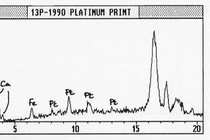Conservation Journal
April 1992 Issue 03
Assessment on the RCA/V&A Conservation Course: Essays, Proposals and Projects
One of the questions most commonly asked by students thinking of applying for the Conservation Course is whether the assessment procedures include unseen examinations. The prospect seems particularly alarming for students for whom some considerable time has elapsed since they were last subjected to this form of ordeal. For an arts graduate turning to scientific studies, the idea of being locked in a room for two hours with a series of questions on molecules can be genuinely traumatic.
While it is not the purpose of an examination board to yield automatically to such fears, there are other factors which argue against such methods of assessment as well as some that argue in favour of them. The purpose here is not to debate these points but to illustrate how productive in terms of written work the Course will become, as a consequence of choosing to assess students in other ways. For practical conservation students, these include a series of essays, a research project, seminar presentations, an assessment of practical work, associated documentation and general performance in the studio and an annual viva voce examination. Students registered for degrees by research are assessed on a written research proposal, seminars and, of course, their final thesis.
Practical students complete three essays in the first four terms of their Course. The first of these is on an aspect of art or design history relevant to their chosen discipline. The second is scientific. It may be general in character and fairly basic or more specialised and advanced according to the background of the student. The third encourages students to approach objects of interest to them from the point of view of materials and techniques of production. These essays are meant to be fairly brief and manageable exercises, based on secondary source materials, which allow students to familiarise themselves with the library facilities of the Department, the Museum, the College, Imperial College and South Kensington in general. They are not intended to distract students to too great a degree from their practical work or other essential aspects of their 'learning experience' as conservators. It follows that they are not intended to be works of high scholarship and original research. The quality and level achieved will depend very much on the previous education of the student and the subject addressed. Some are nonetheless impressive and many offer a broad review of a subject with a bibliography and illustrations which might prove useful to staff or students, within the Museum or elsewhere, in need of an introduction.
The research projects, which occupy a whole term in the second year of the Course, offer students the opportunity to do something more substantial. These projects ought to make a small but original contribution to conservation. Students may choose to cover scientific, technical or historical aspects of conservation and aspire to a piece of publishable work as the end result. Again, staff and students may be interested to know in what areas conservation students are making their investigations and on occasion wish to refer to the project reports.
The proposals prepared by re-search students and eventually their theses prepared for MA, MPhil or PhD will, it is hoped, describe original work which makes a substantial contribution to our profession. Where serious work in the same subject areas is being done elsewhere, it is very likely that researchers will benefit by being able to refer to the documents prepared by RCA/V&A conservation research students.
The conclusion to be drawn from these paragraphs is that it is worthwhile advertising the existence of essays, project reports, proposals and theses, and this Journal seems an appropriate place to do so. Though the Course is not yet at the end of its first full cycle, there is already a substantial body of work, and no space to include all the abstracts so far received on these pages. The selection which follows is rather arbitrary. Future issues will bring the list up to date and additions will be provided periodically thereafter.
No system is yet in place by which colleagues can arrange to borrow or consult the documents in question. A formal system will be needed which, among other things, ensures acknowledgement for the students who have done the work. For the moment, initial enquires should be addressed to the Course Leader.
Research Projects
A Comparison of the Use of Metal Alloy Solders and Epoxy Resins for the Repair and Conservation of Metal Artefacts
Stephen Newman
Metals Conservation, October 1989 - October 1992
12,000 words with tables and charts of results, diagrams and photographs of equipment
The aim of the project was to compare the bond strengths achievable in butt-joined silver samples using a 'hard' metal alloy solder, a 'soft' solder and two epoxy resin adhesives. Test pieces were prepared with a range of surface finishes and two different thicknesses, and tested on a cantilever-type bend test rig in the Materials Department of Imperial College. The experiments indicated that very weak and inconsistent bonds are produced when epoxies are used in this manner. The project also includes an introductory section on solders.
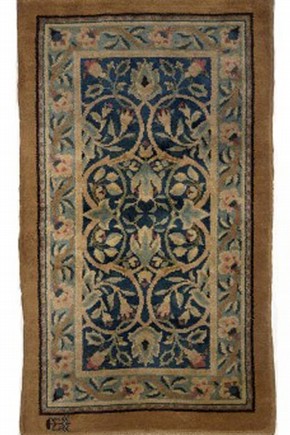
The William Morris Rug (Museum no. T.104-1953) which Diana Drummond has studied in depth and compared with the 'Fremlin' carpet in her 3rd Year research project (click image for larger version)
A Comparative Study of Two Carpets: The Fremlin Carpet and an Early William Morris Rug
Diana Drummond
Textiles Conservation, October 1989 - October 1992
22,000 words with 51 illustrations, 19 figures and 5 tables
The project was inspired by and organised around the opportunity to study an early William Morris rug, made as a wedding present for Burne-Jones's daughter and 'the Fremlin', an early example of an Indian carpet presumed to have been commissioned by William Fremlin during his service with the East India Company between 1626 and 1644. The first part of the research involved the analysis and comparison of the two pieces in terms of structure, technique and materials. Design is also discussed, but primarily in terms of specific sources and as it relates to technique.
The second part of the project was prompted by the need to assess possible methods for the conservation of the Fremlin carpet as it was intended for display in the Nehru Gallery of Indian Art. The condition, previous restoration and conservation are addressed.
Design History Essays
The Vernacular Chair and the Arts and Crafts Movement
Albert Neher
Furniture Conservation, October 1990 - October 1993
4,300 words with 24 illustrations
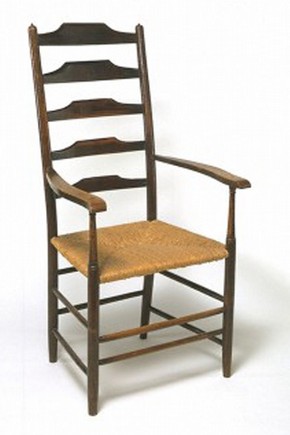
A 'Clisset' style armchair (Museum no. CIRC.511-1962) as discussed in Albert Neher's essay: 'The Vernacular Chair' (click image for larger version)
The country-made ladder backed chair has always had a presence in the English home - the modest role of the kitchen chair. However, the 1860s and the origins of the Arts and Crafts movement saw its status grow to the chair of choice. The history of the movement's adoption of the vernacular chair and the many interpretations it went through at the hands of some of the turn of the century's most significant designers are traced and illustrated.
Rugs and carpets represent a lamentably neglected and under-developed area of textiles conservation. The project includes a review of the scant literature available and a critique of current thought and practice but does not attempt to prescribe improved methods of conservation. The discussion remains primarily theoretical but hopefully high-lights areas for future research and offers constructive criticism and suggestions.
English Rococo Picture Frames and Mirror Frames
Stephen Sheasby
Furniture Conservation, October 1990 - October 1993
5000 words with 112 illustrations
Rococo is a style of decoration which originated in France in the early 18th century and is characterised by the use of elaborate but graceful, light decoration, often containing asymmetric motifs. The essay surveys the development of French and English rococo deco-ration and compares the two styles. English rococo designs for picture and mirror frames are examined using the designs of Matthias Lock, Thomas Johnson, William and John Linnel, William Ince and John Mayhew.
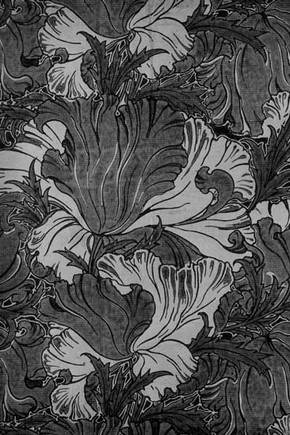
A design by Voysey (Museum no. E.1923-1934), one of the wallpapers discussed in mark Sandiford's history of design essay (click image for larger version)
Wallpaper Design 1860 - 1905: The Aesthetic Movement to English Art Nouveau
Mark Sandiford
Wallpapers and Large Works of Art on Paper, Paper Conservation, October 1991 - October 1993
3500 words with 6 illustrations
The essay traces the evolution of wallpaper design through the Art and Crafts to English Art Nouveau as a development or continuing definition of ideologies, basically laid out in the middle of the 19th century. This is illustrated in the transition from the neutrality and safety of the early Aesthetes (reacting to the opulence of the high Victorian) to the strong, definite designs of the Arts and Crafts, and in turn to the reactionary Art Nouveau which embraced symbolism and an element of eroticism. The essay highlights the continuing threads which emerge from this period and which are considered to constitute 'good design'.
Nursery Wallpapers, 1850 - 1914
Phillippa Mapes
Wallpapers and Large Works of Art on Paper, Paper Conservation, October 1991 - October 1993
5000 words with 12 illustrations
The essay provides a general history of nursery wallpaper showing the effects of social and economic trends of the time on the development of this small, very specific market. It examines the dependence on the new mechanisation of the wallpaper industry as opposed to the use of traditional hand block techniques, to make production cost effective. The essay also explores contemporary attitudes to 'good taste' in wallpaper design, and reactions against cheap machine made wallpapers. It shows how both these factors could be reconciled to produce affordable yet good quality nursery designs.
Women Photographers of British Royalty, 1857 - 1953
Megan Gent
Photographic Materials, Paper Conservation, October 1991 - October 1993
6,000 words with 11 illustrations
The essay presents a general history of women photographers of the period with particular reference to the following photographers: Miss Day, Queen Alexandra, Mrs Albert Broom, Alice Hughes, Lallie Charles, Madame Yevonde and Dorothy Wilding. It focuses on particular examples of their work and their photographic styles in relation to the photographic processes they used. The essay also comments on how their sitters valued and used photography and how these photographs influenced public perceptions of British Royalty.
'Coptic' Textiles: From Picture ... to Pattern
The chronology, style and iconography of textiles found in Egypt dating from the 3rd to the 11th century
Jenny Potter
Textiles Conservation, October 1991 - October 1994
4000 words with 25 illustrations
This essay gives a very brief introduction to the fascinating world of textiles found in Egypt and thought to date from the third to the 11th or 12th century AD. They are commonly known as 'Coptic', a rather imprecise term which is defined slightly differently by different authors. A synopsis of definitions is presented. The socio-political background against which the objects were made is outlined and a list of important dates is included. The chequered history of the objects during and after excavation, which has led to many problems of dating, is covered. There is a brief survey of the richly varied iconography of the period, which stretches from the refined model-ling of the Graeco-Roman period to the iconoclastic and intricately patterned textiles of early Islam.
A supplement on weaving techniques is included.
Seat Upholstery, A Glance at the First Half of the 19th Century
Derek Balfour
Upholstery Conservation, October 1991 - October 1993
4500 words with 32 illustrations
The classical designs of the 18th century continued to develop into the 19th century and eventually became known as the Regency Style. Other revivals included Louis XIV style which developed into the 'Victorian' furniture we are all familiar with. The essay looks at types of seat upholstery and their outlines. The covering materials and trimmings were many and varied. Caned seat furniture with loose cushions was fashionable and fashion played its part then just as it does today. There were many books of design published during the late 18th and early 19th centuries which influenced the development of the neoclassical style. These are used to illustrate the variety of seat furniture which was available. As the title suggests, the essay man-ages only a brief look at the surface of the subject.
Materials and Techniques Essays
Plyformed Furniture
Albert Neher
Furniture Conservation, October 1990 - October 1993
6000 words with 16 illustrations
Plyform is the term used to de-scribe furniture made from laminations of thin veneers pressed into shape - often incorporating compound curves - and held in position by adhesive. The popular plyformed furniture made by Charles Ray Eaves, Alvar Aalto et al was the product of more than a century of experimentation and technological achievement in wood lamination. The essay charts the development of plyform technology from its early manifestations through to contemporary mass production methods.
English Regional Chairs
Stephen Sheasby
Furniture Conservation, October 1990 - October 1993
3500 words with 23 illustrations
Regional chair making traditions developed in England in the late 17th and early 18th centuries. They primarily consist of ladder back, spindle back and Windsor chairs. The styles of these chairs varied from region to region and were based on tradition rather than fashion. The essay examines in detail the materials and techniques used in the making of an English regional chair with illustrations and photographs of the various processes involved. Particular emphasis is placed on the investigation of the surface finishes used in regional chair making.
Research Proposals
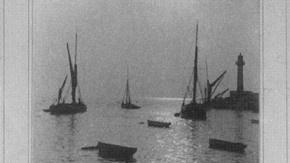
Jacqueline Rees' research involves the study of photographic materials using modern analytical techniques; this photograph (Museum no. 2183-1980) is readily identified as a platinum print via characteristic peaks in the XRF spectrum (click image for larger version)
The Identification of Photographic Processes in Late 19th and Early 20th Century Prints
Jacqueline Rees
Photographic Materials Research, Science Conservation, October 1991 - October 1993
11,000 words plus bibliography
The identification of photographic processes is carried out at present by eye. There is a need to develop a more reliable, objective and scientific approach to the procedure. For several reasons, however, photographic prints do not lend themselves easily to scientific analysis. Most importantly, sampling is not usually ethically viable and so only techniques which are non-invasive as well as non-destructive can be employed. Initial studies have been made into the use of Energy Dispersive X-Ray Fluorescence (EDXRF, a technique which meets these requirements. The maim aim of the proposed research is to further develop EDXRF in this application, particularly as a quantitative, rather than primarily a qualitative technique.
The proposal provides a review of the work done to date and outlines the various analytical methods which are of potential use in the study of photographic materials. The plans for a series of experiments to develop EDXRF as a quantitative method are outlined. An appendix provides a brief introduction to the chemistry of the photographic process.
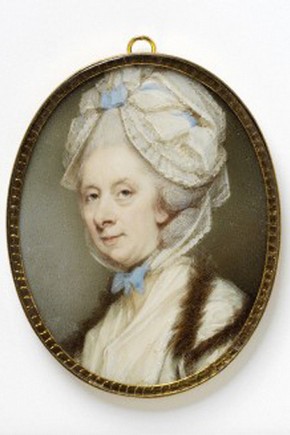
In the 18th century most English portrait miniaturists such as Jeremiah Meyer, began to paint on ivory. Janet Gilburt's research will address the changes in techniques and materials as artists adapted to this new medium (Miniature of an unknown lady; Museum no. EVANS 166) (click image for larger version)
A Study of the Techniques and Materials Used by English Portrait Miniaturists from 1650 to 1800
Janet Gilburt
Portrait Miniatures Research, Paintings Conservation, October 1991 - October 1993
10,000 words plus bibliography
Little has been written on the techniques and materials used by English miniature painters in the late 18th century, compared with the wealth of information about those used by artists in Tudor and Stuart times. Unlike the early miniatures, those from this later period are painted mainly on ivory rather than parchment. It is likely, therefore, that other materials and techniques were altered to suit the new support. The proposal provides a plan for library-, object- and laboratory-based research over two years. The early stages of the research will concentrate on the identification and examination of primary documentary source material so that theoretical practices of the period can be established. It will also enable the results of any subsequent scientific analyses to be interpreted in context. The initial examination of objects will involve a detailed microscopic examination of paint from contemporary artists' palettes as well as the surfaces of unframed miniatures. A chemical analysis of selected materials and areas of the paintings will be used to confirm tentative compositional information indicated by the microscopic analysis. The proposal includes a summary of knowledge to date and establishes particular areas for investigation. It reviews microscopic and instrumental methods of analysis which have potential in the study of miniatures and explains the potential applications of the research, which are twofold. Firstly, to aid the conservator in the early detection of objects which may be at risk and in the preservation and restoration of damaged miniatures. Secondly, to aid the curator in resolving questions of authenticity and the attribution of miniatures to particular periods of individual artists.
April 1992 Issue 03
- Editorial - What is Research?
- The Resurrection of Death on a Pale Horse
- Vessel Glass Deterioration in the Museum Environment: A Quantitative Study by Surface Analysis
- The Mounting and Framing of a Large Work of Art on Paper; a Case Study
- Graphic Descriptions: Side-lights from Manuscript Sources on English Drawing Materials
- Conservation Study Day at the V&A 1991
- Assessment on the RCA/V&A Conservation Course: Essays, Proposals and Projects
